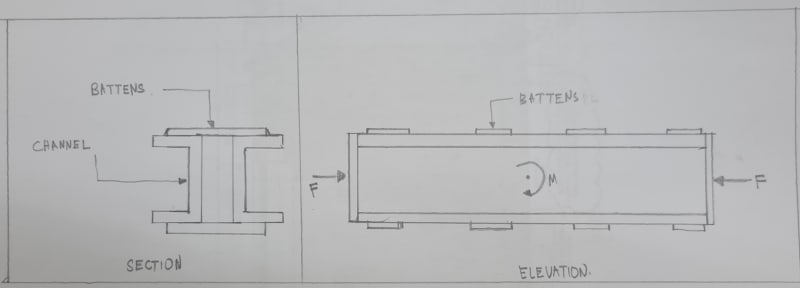Hello All,
I have been trying to verify a spreader beam with a double channel built-up section with batten plate as connectors between the channels as shown in the following figure. The beam is subjected to axial compression force and bending moments.
As I read from the codes and forums, the following steps are to be followed in the design of the beam. Requesting your aid in correcting me in the methods.

1. Find the properties such as Ixx, Iyy, rxx, ryy of the individual section. Check for the slenderness modification factor as per section E6 of the AISC 360. (In my case, the a/ri ratio is less than 40 and the batten plates connected to the channels by means of welding, the slenderness modification factor is 1 as per equation E6-2a)
2. Check for the element slenderness as per Table B4.1A and Table B4.1B. Identify whether local buckling of the elements controls the design. (In my case the sections are compact).
3. Consider an effective length factor of 2.0 based on an assumption of the cantilever in order to account for the absence of lateral restraint of the beams during lifting.
4. Check section E3 for flexural buckling of the section.
5. Check section E4-2 for the torsional and flexural torsional buckling.
6. Check yielding of the section with the bending moment as per F2.1
7. It might be required to check the lateral torsional buckling of the section as per F2.2. But it is not mentioned specifically for the built-up section (apart from F13.4) similar to this case. Should we consider any reduction in the strength due to the shear deformation of the stiffeners?
8. Check the combined effects as per section H for moment and axial forces.
9. Check for shear strength as per section G.
10. Check the web crippling and yielding of the webs with concentrated loading as per J10-2 and J10-3.
11. Design of the batten plates is not covered in AISC 360. Indian Code IS 800 suggests using 2.5% of the axial load to consider on the battens as transverse shear forces and moments. Verify the dimensions of the batten plates as per the code recommendations.
12. Design the welded connection of the batten plates by combining the transverse shear and moment as per IS 800 and longitudinal shear resulting from major axis bending (VQ/IB).
I have been trying to verify a spreader beam with a double channel built-up section with batten plate as connectors between the channels as shown in the following figure. The beam is subjected to axial compression force and bending moments.
As I read from the codes and forums, the following steps are to be followed in the design of the beam. Requesting your aid in correcting me in the methods.

1. Find the properties such as Ixx, Iyy, rxx, ryy of the individual section. Check for the slenderness modification factor as per section E6 of the AISC 360. (In my case, the a/ri ratio is less than 40 and the batten plates connected to the channels by means of welding, the slenderness modification factor is 1 as per equation E6-2a)
2. Check for the element slenderness as per Table B4.1A and Table B4.1B. Identify whether local buckling of the elements controls the design. (In my case the sections are compact).
3. Consider an effective length factor of 2.0 based on an assumption of the cantilever in order to account for the absence of lateral restraint of the beams during lifting.
4. Check section E3 for flexural buckling of the section.
5. Check section E4-2 for the torsional and flexural torsional buckling.
6. Check yielding of the section with the bending moment as per F2.1
7. It might be required to check the lateral torsional buckling of the section as per F2.2. But it is not mentioned specifically for the built-up section (apart from F13.4) similar to this case. Should we consider any reduction in the strength due to the shear deformation of the stiffeners?
8. Check the combined effects as per section H for moment and axial forces.
9. Check for shear strength as per section G.
10. Check the web crippling and yielding of the webs with concentrated loading as per J10-2 and J10-3.
11. Design of the batten plates is not covered in AISC 360. Indian Code IS 800 suggests using 2.5% of the axial load to consider on the battens as transverse shear forces and moments. Verify the dimensions of the batten plates as per the code recommendations.
12. Design the welded connection of the batten plates by combining the transverse shear and moment as per IS 800 and longitudinal shear resulting from major axis bending (VQ/IB).
